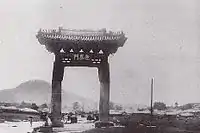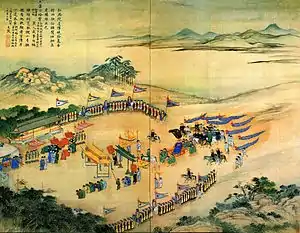| Yeongeunmun | |
|---|---|
영은문 | |
 Picture of Yeongeunmun before demolition | |
| Former names | Yeongjomun |
| Alternative names | Yeonjumun, Yeoneunmun |
| General information | |
| Status | Demolished |
| Type | Gate |
| Country | Korea |
| Coordinates | 37°34′20″N 126°57′37″E / 37.57220°N 126.96030°E |
| Completed | 1537 (renamed in 1539) |
| Demolished | 1895 |
| Korean name | |
| Hunminjeongeum | 영은문 |
| Hanja | |
| Revised Romanization | Yeongeunmun |
| McCune–Reischauer | Yŏngŭnmun |
Yeongeunmun (Korean: 영은문; Hanja: 迎恩門) or Yeongeunmun Gate was a Joseon-era former gate near present day Seoul, South Korea. Since it was a symbol of China's diplomatic influence on the Joseon, the Gaehwa Party of the Joseon government intentionally demolished it in February 1895, seeking for complete political independence of Joseon from China.
History
For a long time, the Joseon Dynasty continued its diplomatic policy with the Late Chinese Empires in an arrangement respecting the political influence of China. This was typically called as Sadae (사대; 事大), which translates literally"serving" (사; 事; Sa) the "greater" (대; 大; Dae) country (usually translated into suzerainity, flunkeyism or the term "serving the Great"). This mode of diplomatic relationship was later forced by the Qing dynasty, through the Qing invasion of Joseon in 1636.[1]
Located at the current northwestern part of Seoul, South Korea, the Yeongeunmun was one of Joseon's materialized symbols of Sadae. In 1407, King Taejong of Joseon built a special state guest house for Chinese envoys to rest en route from China to Joseon, outside of Seoul's West gate. It was named "Mohwa Pavilion" (모화루; 慕華樓; Mohwaru), literally in meaning of "Pavilion" (루; 樓; Ru) "admiring" (모; 慕; Mo) "Chinese civilization" (화; 華; Hwa).[2] Its name was later changed to "Mohwa Guesthouse" (모화관; 慕華館; Mohwagwuan) in 1430 by King Sejong the Great of Joseon, simply changing meaning of "Pavilion" to "Guesthouse" (관; 館; Gwan).[3]
King Sejong also built a Hongsalmun (홍문; 紅門) near the Mohwa Guesthouse. This guesthouse had an arrow-shaped decoration on its top. It was then reconstructed into a new gate in 1537, and became notorious after it was officially named as "Yeongjomun" (영조문; 迎詔門) by Jungjong of Joseon, literally in meaning of "Gate" (문; 門; Mun) "welcoming" (영; 迎; Yeong) "messages from China" (조; 詔; Jo).[4] Yet, Chinese diplomats insisted they were not just delivering messages, so the name of gate was changed to Yeongeunmun in 1539, meaning "Gate welcoming grace from China". Though its official name was confirmed as Yeongeunmun from that time, it was also called as Yeonjumun or Yeoneunmun. The structure had a hip roof and columns over two long plinths.[5]
Demolition
In late 19th century, The Gaehwa Party of Joseon tried to modernize the country. One of its political goals was turning Joseon into a completely independent state. So in February 1895, during a period called the Gabo Reform, the Gaehwa Party demolished Yeongeunmun to show Joseon's enthusiasm of independence around the world. They thought the Mohwa Guesthouse could be reformed into another use, yet Yeongeunmun had to be demolished.[6] Meanwhile, Soh Jaipil, a Korean-American political activist supporting independence of Joseon, planned the building of a new gate near the ruins of a demolished Yeongeunmun to symbolize the independent status of Joseon and his plan eventually obtained support from King Gojong. After Joseon was reestablished into the Korean Empire in 1897, there was a new gate built by Soh Jaipil, named as 'Independence Gate', at the site overlooking the ruins of the demolished Yeongeunmun. Also, the Mohwa Guesthouse was reformed into an "Independence Hall" (독립관; 獨立館; Dongnipgwan).[7] For this long historical background, in 1963, South Korean government has designated the ruins of the demolished Yeongeunmun as a Historic Site of South Korea, and relocated them to another place for preservation in 1979.[5]
Gallery
 Picture describing Qing envoy greeted by the King of Joseon
Picture describing Qing envoy greeted by the King of Joseon Picture of Yeongeunmun from other side
Picture of Yeongeunmun from other side
See also
References
- ↑ "History of Korea > V. Joseon Society Focused on the Yangban Class > 5. The Struggle against the Japanese and Manchus". contents.history.go.kr. National Institute of Korean History. Retrieved 2022-08-01.
- ↑ 太宗恭定大王實錄 [태종실록 - 태종 7년 8월 22일 '송도의 연빈관을 모방하여 서문 밖에 새로 모화루를 짓다'] (in Korean). National Institute of Korean History. Retrieved 2022-08-01.
- ↑ 世宗莊憲大王實錄 - 地理志 [세종실록지리지 - 경도 한성부] (in Korean). National Institute of Korean History. Retrieved 2022-08-01.
- ↑ 中宗恭僖徽文昭武欽仁誠孝大王實錄 [중종실록 - 중종 32년 1월 2일 '삼공이 홍문을 영조문으로 할 것을 건의하다'] (in Korean). National Institute of Korean History. Retrieved 2022-08-01.
- 1 2 "Historic Site - Plinths of Yeongeunmun Gate, Seoul". english.cha.go.kr. Cultural Heritage Administration. Retrieved 2022-08-01.
- ↑ "신편 한국사 > 근대 > 40권 청일전쟁과 갑오개혁 > III. 갑오경장 > 2. 제2차 개혁 > 3) 제2차 개혁의 내용". contents.history.go.kr (in Korean). National Institute of Korean History. Retrieved 2022-08-01.
- ↑ Fuchs, Eckhardt; Kasahara, Tokushi; Saaler, Sven (2017). A New Modern History of East Asia. V&R unipress GmbH. pp. 145–147. ISBN 9783737007085.